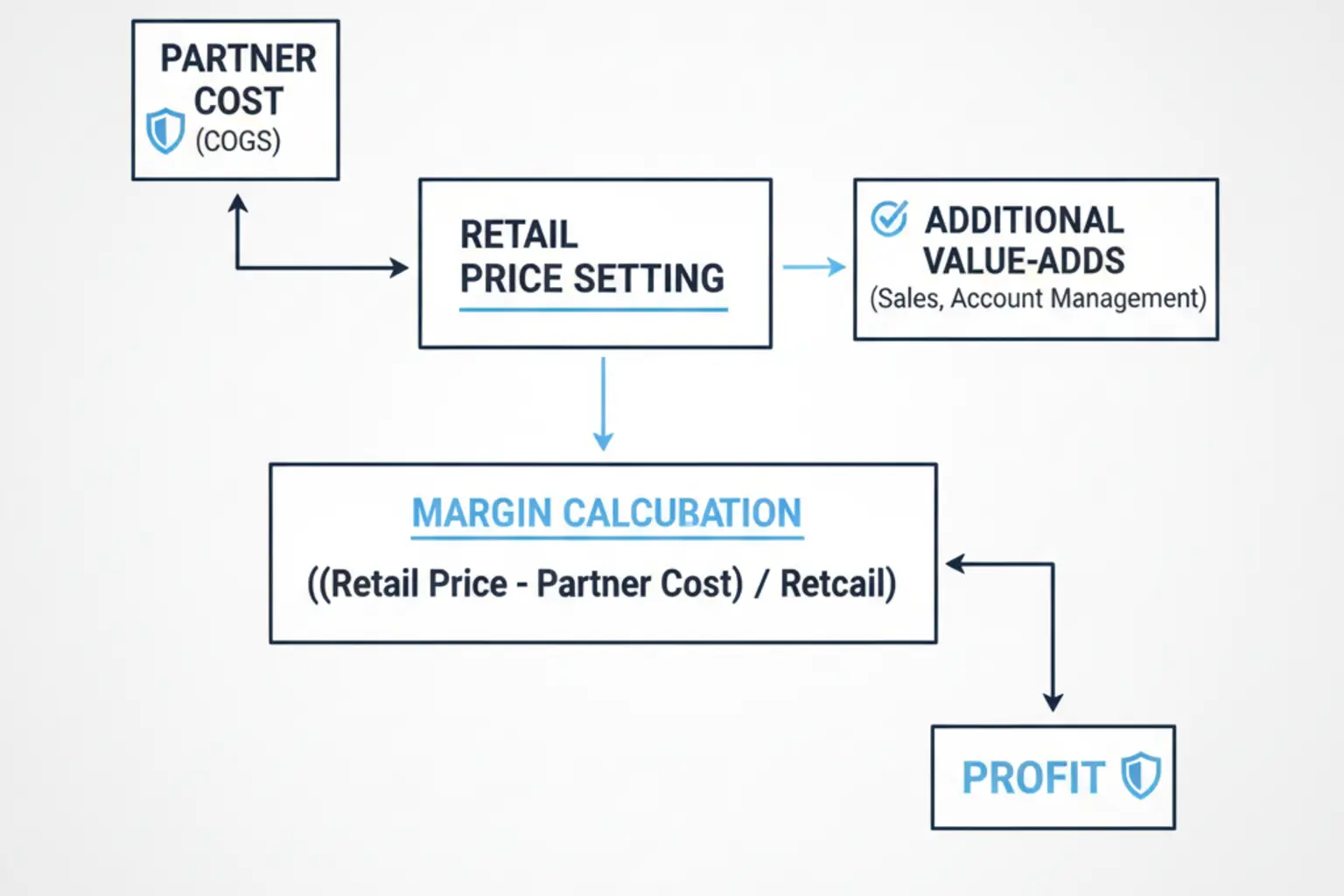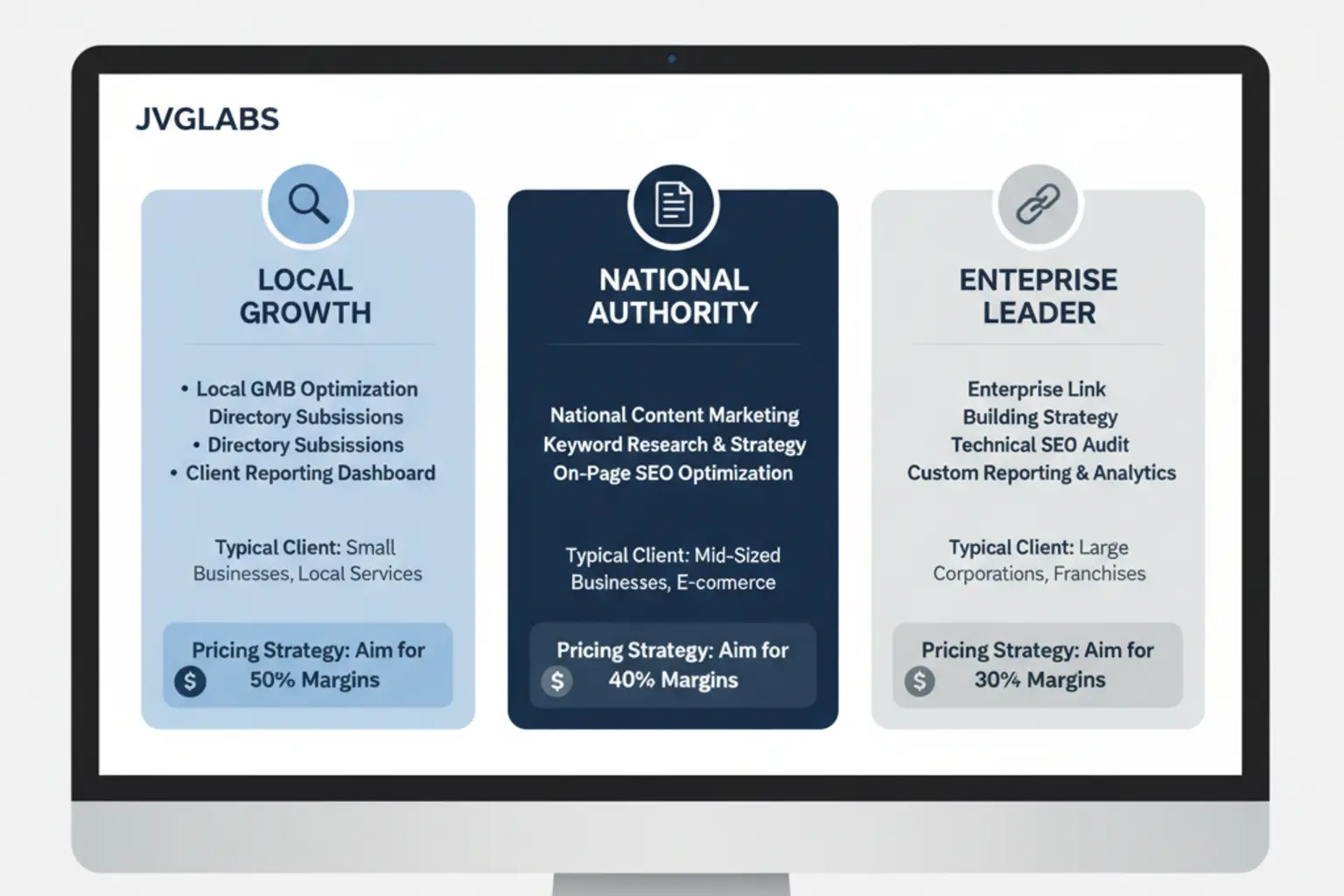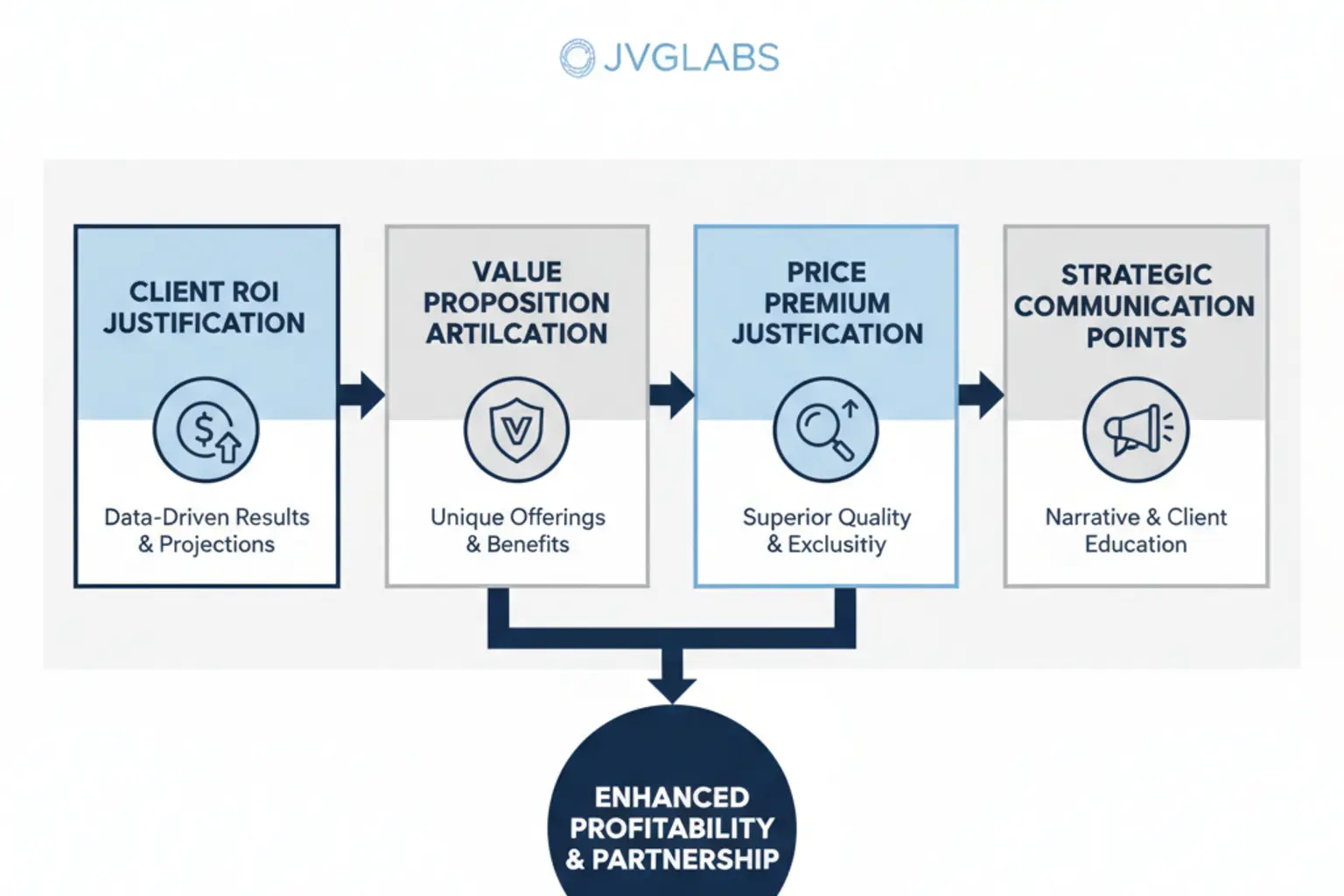The Agency Playbook: A Guide to Profitable SEO Pricing and Packaging
You’ve decided to offer SEO, but you face a critical question that most pricing guides ignore: How do you profitably price and package services that you aren’t fulfilling yourself?
Standard advice about calculating your hourly rate or capacity falls flat when you’re partnering with a white-label provider. The math is different, and so is the value proposition.
You’re not just selling tasks; you’re selling a managed, scalable solution that drives client growth while protecting your brand.
This isn’t a theoretical guide—it’s a financial playbook for agency leaders who want to resell SEO services. We’ll break down the financial architecture you need to calculate healthy margins, design compelling packages, and build a profitable, scalable SEO revenue stream, all while a partner like JVGLABS handles the execution invisibly in the background.
Part 1: Understanding the Core SEO Pricing Models (The Foundation)
Before you can build a profitable reseller model, you need to master the three fundamental pricing structures. While top guides from sources like The Blueprint Training and Wix cover these well for agencies doing the work in-house, we’ll analyze them through the specific lens of a white-label reseller.

The Monthly Retainer
This is the most popular model, used by over 53% of agencies for good reason. The client pays a fixed fee each month for an ongoing scope of SEO services.
How it works: You agree on a set of monthly deliverables and strategic goals, providing predictable revenue for you and consistent momentum for the client. Industry data shows typical retainers range from $1,500 to $5,000 per month for small to mid-sized businesses.
Pros: Predictable cash flow, fosters long-term client relationships, and aligns perfectly with the continuous nature of SEO.
Cons: Can lead to scope creep if the Statement of Work (SoW) is not crystal clear.
White-Label Reseller Consideration: This model is an ideal fit for reselling. You can secure a fixed-cost retainer package from your white-label partner and sell it to your client with your margin built in. This approach simplifies billing and financial forecasting for your agency.
Project-Based Pricing
This model involves charging a fixed price for a specific, one-time project with a clear start and end date.
How it works: Common projects include a technical SEO audit, a content migration plan, or a foundational link-building campaign. You define the exact scope, timeline, and total cost upfront.
Pros: Expectations are clear for both you and the client, and it’s a great way to start a relationship with a new client who isn’t ready for a full retainer.
Cons: Revenue is inconsistent and can create administrative overhead from managing multiple one-off projects.
White-Label Reseller Consideration: You can easily sell project-based work by getting a quote from your partner and adding your margin. This works well for offering high-value “foot-in-the-door” services like comprehensive site audits, which can then be used to upsell a monthly retainer.
Hourly Billing
With hourly billing, you charge the client for the actual time spent on their account. While some freelancers use this, most established agencies avoid it.
How it works: You track hours and bill the client at a pre-agreed rate, which typically falls between $100 and $300 per hour for agency work.
Pros: Ensures you are paid for all work performed.
Cons: It incentivizes inefficiency, not results. Clients may micromanage hours, and it’s difficult to scale because your revenue is capped by time.
White-Label Reseller Consideration: This is the least effective model for reselling. Your partner operates on a fixed-cost basis, making it difficult to align with variable hourly billing. It introduces unnecessary complexity and positions your service as a commodity, not a strategic solution.
Part 2: The Financial Architecture of a White-Label Reseller
Here’s where agencies often get it wrong. Pricing outsourced SEO isn’t about marking up a cost; it’s about building a financial model that accounts for your partner’s fee, your own operational costs, and the unique value you provide.

Step 1: Define Your Cost of Goods Sold (COGS)
In a white-label model, your primary COGS is simple: it’s the fee your SEO partner charges for fulfillment. This is your baseline cost for execution.
Step 2: Calculate Your Target Margin
Your margin is the profit you make on top of your COGS. A healthy gross margin for reselling white-label services should be between 40% and 50%. This ensures you can cover your own costs and generate a healthy profit.
These costs include:
- Sales & Marketing: The effort it takes to acquire the client.
- Account Management: Your time spent on client communication, strategy calls, and reporting.
- Overhead: Your agency’s operational expenses.
- Profit: The ultimate goal.
Use this simple formula:
Gross Margin % = (Your Retail Price – Partner Cost) / Your Retail Price
Example in Action:
Your white-label partner quotes you $1,000/month for a national SEO package.
To achieve a 50% margin, you need to set your retail price at $2,000/month.
Let’s check the math:
($2,000 – $1,000) / $2,000 = $1,000 / $2,000 = 0.50, or 50%.
That $1,000 difference isn’t pure profit. It’s the revenue that pays for your strategic oversight, client relationship management, and business growth. That is the financial foundation of a scalable white-label SEO services offering.
Part 3: Designing Scalable White-Label SEO Packages
Once you understand the financial model, you can design packages that are easy for clients to understand and simple for you to sell. The most effective approach uses a tiered framework that aligns with different client needs and budgets.

The 3-Tier Framework: Local, National, and Enterprise
This structure allows you to meet clients where they are and provide a clear path for growth.
Tier 1: The “Local Growth” Package
-
Ideal Client: Small, service-based businesses like dentists, plumbers, or local law firms.
-
Core Goal: Dominate the local search map and drive foot traffic or local leads.
-
Typical Deliverables:
- Google Business Profile (GBP) optimization and management
- Local citation building and cleanup
- On-page SEO for 5-10 core local keywords
- Location-specific landing page optimization
- Monthly performance reporting
-
Pricing Example:
- Partner Cost: $750/month
- Your Retail Price: $1,500/month (50% margin)
Tier 2: The “National Authority” Package
-
Ideal Client: E-commerce stores, SaaS companies, or national brands.
-
Core Goal: Build topical authority, increase organic traffic, and generate leads on a national scale.
-
Typical Deliverables:
- Everything in Local Growth (if applicable)
- Comprehensive keyword and competitor analysis
- Monthly content strategy (e.g., 2-4 blog posts)
- Foundational link building and digital PR outreach
- Technical SEO monitoring and implementation
-
Pricing Example:
- Partner Cost: $2,000/month
- Your Retail Price: $4,000/month (50% margin)
Tier 3: The “Enterprise Dominance” Package
-
Ideal Client: Large-scale businesses with complex websites or highly competitive keywords.
-
Core Goal: Market leadership, advanced technical SEO, and large-scale content and authority campaigns.
-
Deliverables: Deliverables here are typically based on a custom scope built around the client’s specific needs, which may involve advanced technical fixes, international SEO, or programmatic content strategies. Pricing is custom but should always maintain your target margin.
Pricing Individual Deliverables
You can also offer specific services as project-based add-ons, which is an excellent way to upsell or help clients who need targeted support.
- Technical SEO Audit: A comprehensive one-time audit can be a powerful entry point. (e.g., Partner Cost: $1,200, Your Price: $2,500).
- Link Building Campaign: Sell packages of links based on domain authority or relevance. (e.g., Partner Cost: $1,500 for 5 links, Your Price: $3,000).
Part 4: Advanced Strategy – Mastering Value-Based Pricing
Cost-plus pricing is safe, but value-based pricing is where top agencies create exceptional profitability. This model sets your prices based on the perceived or actual value your services deliver to the client’s business.
As a reseller, your value isn’t just in the execution—it’s in the strategy, the simplification, and the results you enable.

How to Justify Your Margin with Value
Your client isn’t paying you to be a middleman. They are paying for:
- Strategic Oversight: You translate their business goals into a tangible SEO strategy. Your white-label partner executes the tactics; you own the “why.”
- Simplified Communication: You are the single point of contact, distilling complex reports into actionable business insights your client can understand.
- Quality Control and Vetting: You’ve already done the demanding work of finding and vetting an expert execution team, saving your client the time, risk, and expense of doing it themselves.
- Integrated Marketing Knowledge: You understand how SEO fits into their broader marketing ecosystem (paid ads, social media, etc.), something a pure-play SEO provider might miss. The combination of your strategic direction and our AI-powered SEO automation creates a result greater than the sum of its parts.
When you frame the conversation around the business outcome—more leads, higher revenue, greater market share—the cost becomes an investment, not an expense. This approach allows you to command premium prices far above a simple 50% margin, because your value is tied to ROI, not to a list of deliverables.
Frequently Asked Questions
Which pricing model is best for an agency just starting to resell SEO?
The monthly retainer is almost always the best choice. It provides predictable revenue for you and a clear cost for your client, and it aligns perfectly with the ongoing nature of a white-label partnership. Start with a well-defined “Local Growth” package.
How do I handle client questions about my pricing and margin?
Base your pricing on the comprehensive value you provide—strategy, management, and results. You should never disclose your partner’s costs. Instead, frame your fee as the total investment required to achieve their goals with your agency as their strategic guide. You are selling a fully managed solution, not just reselling labor.
What if my white-label partner raises their prices?
A good partner will provide ample notice of any pricing changes. It’s wise to review your own pricing annually. You can adjust your rates for new clients immediately and build a planned increase into your contracts for existing clients, giving them 60-90 days’ notice.
Should I create custom packages or stick to the 3-tier model?
Always start with the 3-tier model. It standardizes your sales process and makes it easier to scale. You can always develop a custom proposal for larger, enterprise-level clients, but 80% of your prospects should fit neatly into one of your predefined packages.
From Pricing Models to a Profitable Partnership
Choosing the right pricing model is more than a financial decision—it’s the foundation of your agency’s ability to scale. By moving beyond simple markups and designing a financial architecture built for reselling, you can offer powerful SEO solutions without the overhead of an in-house team.
Your role becomes that of the trusted strategist, guiding the client’s growth while you own the relationship and the high-level direction. Behind the scenes, a partner like JVGLABS provides the execution engine, automation, and technical expertise to bring your strategy to life—all under your brand.
When you get the pricing and packaging right, you’re not just selling SEO. You’re building a scalable, profitable, and valuable new revenue stream for your agency.

